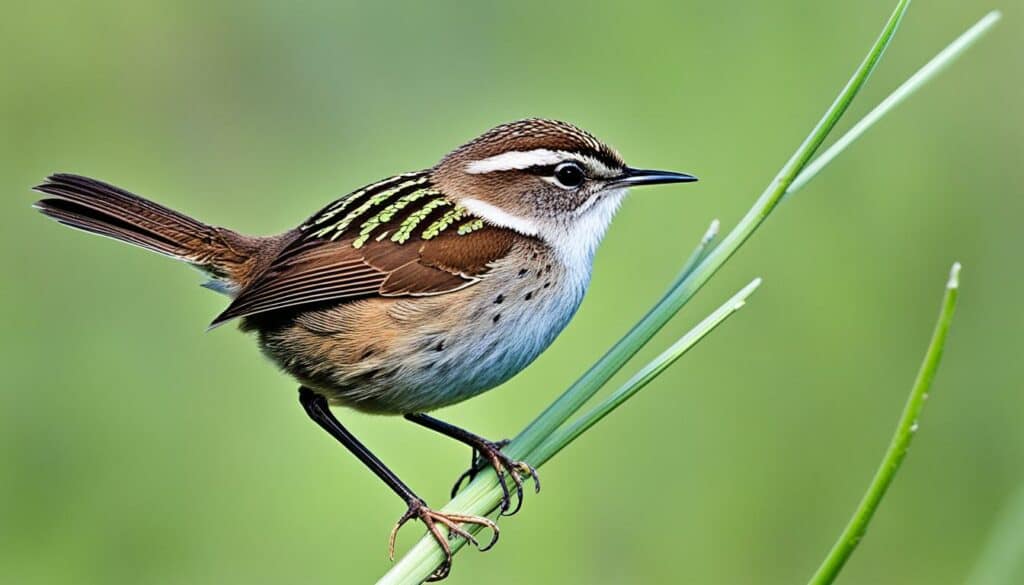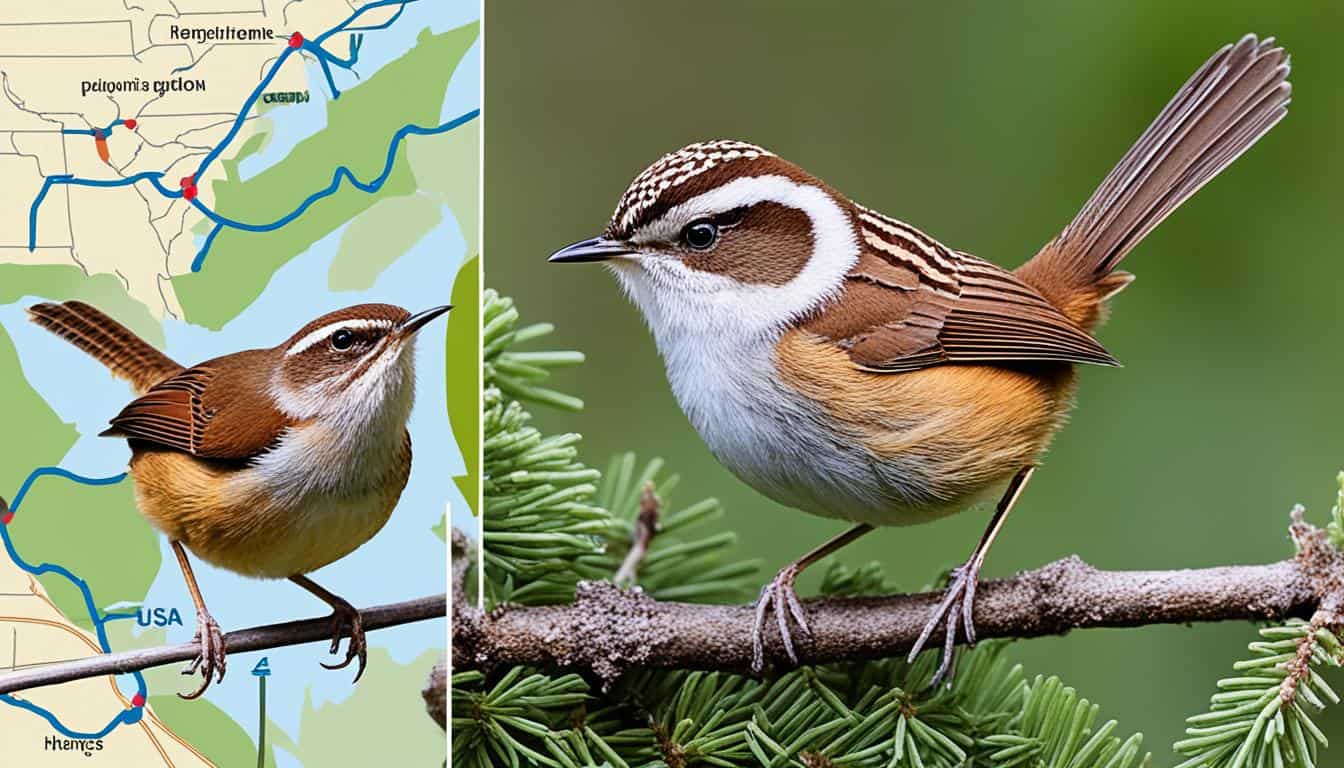Ever thought about how to spot various wren types in the USA? Wrens captivate us with their inquisitive nature and sweet songs. Yet, seeing them clearly takes more than just a quick look.
The USA’s varied terrain is home to many wren species, each unique. For instance, the Carolina wren sings beautifully, while the house wren is known for its cute behavior. These differences make wren watching truly exciting.
Wrens are part of the Troglodytidae family, famous for their love of hidden spots. This bit will focus on their songs and manners, making ID-ing them fun. Find out how to spot wrens like the Carolina wren. And explore the wonderful wrens of the Southwest.
Introduction to Wren Species in North America
American wren species are known for their lively and spirited behavior. They draw the interest of bird watchers everywhere. These birds are small and part of the Troglodytidae family. They often explore, moving in and out of small spaces and bushes.
Overview of Wren Families
Many wren species in North America belong to the Troglodytidae family. They have brown feathers and make complex sounds. These wrens are skilled at building detailed nests. The different species range from Carolina wrens on the East Coast to cactus wrens in the Southwest. This shows their great variety.
Common Habitats of Wrens in the USA
American wren species can live in many places. They are found in city gardens, thick forests, and even dry deserts. They flourish across North America. The Southwest is especially rich in wren varieties. It’s a prime spot for seeing their bright activities and hearing their songs.
Characteristics of Carolina Wrens
Carolina wrens stand out in the wren family for their dynamic tunes and lively ways.
Physical Description
They’re distinct from other wrens due to their sturdy build. A Carolina wren has a slightly bent bill and a long, hard tail. Their feathers are a chestnut brown above and orange below. A bright white line over the eyes gives them a unique look.
Vocalizations and Songs
Carolina wrens are famous for their loud, clear songs. They sing phrases that ring out and often repeat them. These songs can be heard above other sounds, a thrill for those who enjoy bird listening. Their singing makes the Carolina wren easy to spot, even for new bird watchers.
Habitat and Range
They live in many places, from busy cities to hidden nature spots. Carolina wrens are found nesting in a variety of places, showing their ability to adapt. If you want to find them, look in thick bushes or in piles of leaves where they search for food and find cover.
This adaptability makes them an interesting topic for those intrigued by the variety of wrens in the U.S.
Identifying House Wrens
House wrens stand out because of their unique traits and behavior. This makes them different from other wren types.
Distinctive Features
House wrens are small birds with features that set them apart. They have a faint eyebrow stripe and bold tail markings. These qualities help spot them, even though they look plain.
Behavioral Traits
House wrens sing with joy in the spring. They are very territorial, especially when they’re nesting. This territorial behavior helps in telling them apart.
Nesting Habits
House wrens prefer to nest in existing cavities. They sometimes push bigger birds out to settle there. This competitive nesting behavior is crucial in their identification.
Understanding Cactus Wrens
The cactus wren is Arizona’s state bird and the largest wren in the United States. It is known for building a nest within cholla cactus to protect itself. This bird’s unique features, where it lives, and its songs are worth exploring.
Unique Characteristics
Cactus wrens are bigger than other wrens. They have a speckled chest and a white stripe above their eyes. Their colors help them blend into the desert.
Range and Habitat
Cactus wrens live in the southwestern US and parts of Mexico. They love dry, desert places. These birds use thorny cacti like cholla for their nests.
Vocal Patterns
The way cactus wrens sing is unique. They make a loud, scratchy noise. This helps them defend their territory and talk to each other.
Distinguishing Canyon Wrens
The canyon wren is special among the USA wren types. They are loved for their unique looks and beautiful songs. This makes them key in any USA wren species guide.
Appearance and Size
Canyon wrens are easy to spot with their dark rufous brown feathers. They have white throats and slightly curved bills. Their mix of dark and light colors helps in canyon wren identification.
Song Identification
The canyon wren’s song is unforgettable. Both male and female birds sing a lovely, dropping whistle. Their music echoes through canyons, leaving a lasting impression. It’s not just beautiful but also helps identify them while birdwatching.
Using both what you see and hear about canyon wrens can greatly improve spotting them. Enjoy these amazing birds more in their natural homes.
Features of Bewick’s Wrens
The Bewick’s wren is unique among its peers. It has special looks and sounds. This makes it stand out. Let’s explore what makes it special. This will help you spot it easier and enjoy its company more.
Physical Traits
One key feature of the Bewick’s wren is its bold white eyebrow. It goes from its beak to the back of its head. This creates a sharp contrast with its brownish-grey feathers. You’ll also see they are slim with long tails. Their tails are often upright. These traits help them look different from other wrens.
Vocalizations
Wren species are known for their songs, and the Bewick’s wren is special in this too. It sings high, quick tunes that vary a lot. The songs change slightly based on the region. This tells you where they are from. These unique songs make their home lively with sound.
| Features | Bewick’s Wrens | Other Wrens |
|---|---|---|
| Physical Traits | Bold white eyebrow, slender body, long tail | Varied plumage patterns and sizes |
| Vocalizations | High-pitched, rapid sequences, regional variations | Distinct songs per species, less regional specificity |
Learning about the Bewick’s wren makes birdwatching more fun. It helps you appreciate this lovely bird even more.
How do you identify different species of wrens in the USA?
For those who love wrens, knowing how to identify them across the USA is key. Learning about each wren’s look, voice, and behavior helps tell them apart.
Start by looking at their physical traits. Carolina wrens have white eyebrow stripes, and house wrens have barred tails. Noting these details helps with wren ID.
Next, pay attention to vocal patterns. Each wren has a unique call. The Carolina wren’s is loud and sounds like “teakettle.” Canyon wrens make beautiful descending songs. Knowing these sounds is critical for ID.
Behavioral cues matter too. House wrens are fierce about their space when they nest. Watching how they act can also give you hints about the species.
| Wren Species | Physical Traits | Vocal Patterns | Behavioral Traits |
|---|---|---|---|
| Carolina Wren | White eyebrow, long-stiff tail | Loud, repetitive song | Exploratory and active |
| House Wren | Small size, barred tail | Bubbly song | Highly territorial during nesting |
| Cactus Wren | Largest size, spotted chest | Harsh, rasping notes | Nests in cactus for protection |
| Canyon Wren | Rufous brown, white throat | Melodious, descending song | Often seen in rocky areas |
| Bewick’s Wren | Bold white eyebrow | Varied, melodic songs | Adaptable across regions |
Putting all this together makes you a wren expert. Get sharp at observing and listening. With these skills, you’ll know many wren species in no time.
Recognizing Rock Wrens
The rock wren is very distinctive among wrens. It loves rocky areas and can be seen hopping around boulders. This makes it easier to recognize compared to other wrens.
Physical Description
The rock wren’s colors are mostly grey-brown. It has a tiny eyebrow line, setting it apart from the canyon wren. Its small size and speckled underbelly make it a fun find for birdwatchers.
Typical Behaviors
The rock wren bobs and dips, showcasing a unique movement. It also has a delightful melodic call. These behaviors help birders spot the rock wren in the wild.
Favorite Habitats
Rock wrens love rocky places. They are often found in open canyons, cliff sides, and rocky outcrops. These environments are not just for foraging but are also ideal for nesting.
| Feature | Rock Wren | Canyon Wren |
|---|---|---|
| Coloration | Faint Grey-Brown | Rufous Brown |
| Eyebrow Line | Subtle | Pronounced |
| Behavior | Bobbing and Dipping | More Static |
| Habitat | Rocky Areas | Canyon and Cliffs |
Insights into Marsh Wrens
Marsh wrens have a unique taste in homes. They like to live in thick reeds and cattails. You’ll often hear them before you see them. It’s important to know about marsh wrens to correctly spot them.

Listen for the marsh wren’s sweet song in the marsh. Look for their white eyebrow stripes and streaky backs. They love sitting on top of reeds.
Check out the table below for a clear look at what makes marsh wrens special:
| Feature | Marsh Wren | House Wren |
|---|---|---|
| Habitat | Reeds and cattails in wetlands | Open woods and gardens |
| Markings | White eyebrow stripe, streaked back | Indistinct eyebrow stripe, mostly plain |
| Posture | Often perched on reeds | Perches on various structures |
| Calls | Resonant, often heard in marshlands | Bubbly, prominent in springtime |
Comparing features is key to telling wren types apart. It helps you identify marsh wrens better. This knowledge makes birdwatching in marshy areas more fun and fruitful.
Characteristics of Winter Wrens
Winter wrens are small birds that do well in the cold. To winter wren identification, check their size. They are about 4 inches long. They’re covered in dark brown feathers. This color helps them hide in leaves and bushes.
They have a short, upright tail. This, plus their fast hopping, makes them stand out. You can often find them in messy places.
Listening for their song can also help you find them. Their songs are like trills and whistles. They echo in the forests where they live.
Winter wrens like dense forests. These areas have lots of logs and bushes. Here, they look for bugs and spiders. Knowing where they live makes birdwatching more interesting.
Tips for Attracting Wrens to Your Yard
Wrens bring joy with their vivid colors and sweet songs. To make your yard wren-friendly, start by planting native plants. These not only feed wrens but also give them the perfect spots for hiding and nesting. Choose a variety of shrubs, trees, and flowers that make seeds and draw insects, wrens’ favorite meals.
Adding special features will also invite wrens over. Create places like brush piles and trellises for them to perch and play. Wrens are curious, enjoying exploration. So, make sure your yard has different textures and heights. Including nest boxes with small openings can help wrens feel at home.
Don’t forget about water; wrens love a good splash. A birdbath or a little water structure will give them a place to drink and clean. Keep this area tidy and add a shallow dish with a slight incline for safety. With native plants, diverse structures, and a water spot, your yard will be a haven for wrens. This mix will not only attract wrens but also ensure they stay and bring life to your outdoor space.
FAQ
How do you identify different species of wrens in the USA?
To tell wrens apart, look at unique features. This includes their size, colors, and special marks. Their songs and how they act in different places can also be clues. Each kind of wren has its own look and behaviors that set it apart.
What are some common habitats for wrens in the USA?
Wrens live in many places in the USA, from cities to deserts. The cactus wren likes dry spots and the marsh wren lives near water. Where they live often shows what type of wren they are.
What are the key characteristics of Carolina wrens?
Carolina wrens have big beaks and long tails. They sing loud, beautiful songs. They can live in cities or natural spots. Their songs help you know they’re around.
How can you identify a house wren?
House wrens are small and have unique markings on their face and tail. During spring, you can hear their bright songs. They like to nest in spots that other birds might want too.
What makes the cactus wren unique?
The cactus wren is Arizona’s state bird and the biggest wren in the USA. They make nests in cactus for safety. Their songs are special and are always in their area.
How can you distinguish a canyon wren by its song?
Canyon wrens sing low notes that sound pretty in their rocky homes. This is true for both male and female birds. They look reddish-brown with a white throat.
What are the identifying traits of Bewick’s wrens?
Bewick’s wrens have a bright white eyebrow that helps spot them. They make many kinds of sounds. These sounds can differ from place to place.
How do you recognize a rock wren?
A dark beak and a subtle eyebrow help you spot rock wrens. They love rocky places. They move in special ways and have many sounds.
What sets marsh wrens apart from other wren species?
Marsh wrens are often found in reeds by water. They look and sound different from other wrens. They make specific calls that can help tell them apart.
What are the characteristics of winter wrens?
Winter wrens are small and dark with a lot of energy. They are hardy and live in forests in winter. They behave in their own special ways.
How can I attract wrens to my yard?
Want wrens in your yard? Plant native flowers and add bushes and rocks. Offer birdhouses for nests. A yard full of hiding places welcomes wrens.







